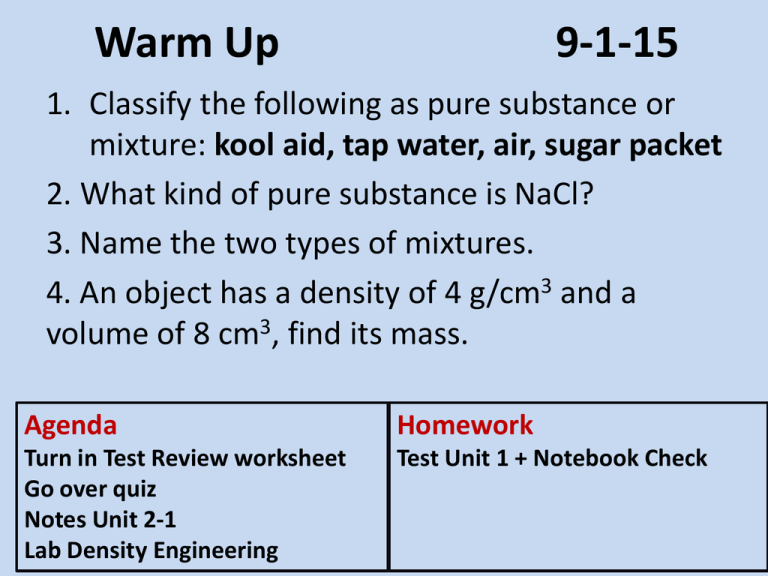Chapter 4-1 Substances Are Made of Atoms
advertisement

Warm Up 9-1-15 1. Classify the following as pure substance or mixture: kool aid, tap water, air, sugar packet 2. What kind of pure substance is NaCl? 3. Name the two types of mixtures. 4. An object has a density of 4 g/cm3 and a volume of 8 cm3, find its mass. Agenda Homework Turn in Test Review worksheet Go over quiz Notes Unit 2-1 Lab Density Engineering Test Unit 1 + Notebook Check Quiz Unit 1 • Version 1 1. 0.03652 kg 2. 2396 cm 3. 0.33 cm3 or 0.25 cm3 4. 180 g 5. When mixing different substances but they do not mix and result in layers. Ex. Cereal and milk 6. Bubbles, color change, temperature change, precipitate (forming solids particles • Version 2 1. 6.53 kg 2. 6.39 cm 3. 0.5 cm3 4. 80 g 5. When mixing different substances and they mix thoroughly resulting in only 1 layer. Ex. Sugar in water 6. Bubbles, color change, temperature change, precipitate (forming solids particles Unit 2-1 Substances Are Made of Atoms Atomic Theory • States that atoms are building blocks of all matter. • Three laws that support the current atomic theory Atomic Theory Current Model Electron cloud instead of orbital The atom model will change when new/better data come out Atomic Theory • Law of definite proportions - chemical compound always contain the same elements in the exact same proportions by mass. Oxygen Carbon Hydrogen C2H6O2 Atomic Theory • Law of conservation of mass – mass cannot be created or destroyed. Mass in reactants equal the mass in products. baking soda CO2 gas vinegar solution Sodium bicarbonate + 2 grams acetic acid 2 grams --------> carbon dioxide + 4 grams total Sodium acetate and water sodium acetate + H 2O Atomic Theory • Law of multiple proportions - the masses of one element which combine with a fixed mass of the second element, are in a ratio of whole numbers. Chemical Name Nitrogen monoxide Nitrogen dioxide Nitrous oxide Water Hydrogen peroxide Formula NO NO2 N2O H2O H2O2 Ratio 1:1 1:2 2:1 2:1 1:1 Atomic Theory • Elements combine in whole numbers Dalton’s Atomic Theory • 1808 – John Dalton combined the three laws and revised the early Greek idea of atoms • Part of his theory are incorrect by today’s standards because of our technology Dalton’s Atomic Theory 1. Matter is made of atoms, which cannot be subdivided into smaller components 2. Atoms of a element are identical in their physical and chemical properties 3. Atoms of different elements differ in their physical and chemical properties 4. Atoms combine in simple, whole-number ratios to form compounds 5. Atoms are rearrange in a reaction but not created, destroyed or changed (transformed) Engineering Challenge • Density and Archimedes’ Principle -Create a boat to hold as much pennies as possible without sinking Assignments Notebook checklist • 5 days of notes = 25 points – Warm ups - questions/answers/date – Notes - Cornell format – Summary with signature Online homework • Extended till 9PM tonight






